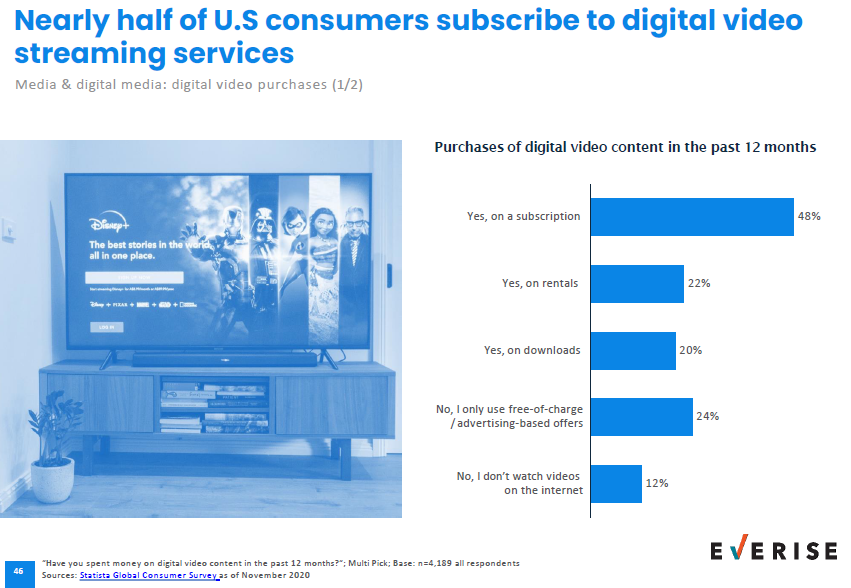-1.png)
Increased global access to the internet created a new era of marketing and audience acquisition. In the modern digital world, normal life happens mostly online, and as more people move towards digital platforms, media brands are expected to keep up with changing user preferences while maintaining an active presence in emerging channels.
According to the Digital 2021 Global Overview Report by We Are Social and HootSuite, 4.66 billion people around the world used the internet in January 2021, up by 316 million (7.3 percent) from 2020. Their study also found that Global internet penetration now stands at 59.5 percent. This global increase in digital users shows a promising upward trend for digital media adoption. Additionally, data from our 2021 U.S. Consumer Report also supports this notion.
Increased consumption of digital content poses several opportunities, as well as challenges for media brands. In recent years, mobile devices have made it easier for consumers to access the internet for digital media consumption such as music, video, and other forms of media. This fast-paced growth on digital platforms can make it more difficult to moderate a brand's online community and user-generated content.
Why do media brands need to focus on content and community moderation? Because the risks of content moderation errors are extreme and can have a lasting negative impact on a brand and its users.
1) While 38% of consumers prefer digital media, there is a large segment of the population ( 29%) who prefer to own hard copies of films, books, or music.
Data from our 2021 U.S. Consumer report suggests that there are still consumers who prefer owning hard copies of media such as films, books, or music. This is backed by other studies that sought to find the value of physical copies of media and how people prefer them over digital ones.
Ozgun Atasoy, a postdoctoral researcher at the University of Basel in Switzerland, and his research partner, Carey K. Morewedge, a marketing professor at Boston University, ran a series of experiments to figure out whether or not digital goods are less valued than physical goods. In one experiment, they found that even when people figured that digital and physical pictures cost about the same, participants who got a physical keepsake were willing to pay even more for a physical copy.
Despite the convenience of digital copies, there is still a need for the capability to provide flexible options to cater to consumer preferences when it comes to media. One of the reasons could be that U.S. consumers have difficulties accessing all this new digital content.
2) Over one-third, (34%) of U.S. consumers state it is too expensive to afford all the streaming services they want. American consumers are slightly more concerned about this compared to other countries.
Video streaming experienced a boom in 2020. Reports show that time spent streaming increased by almost 75 percent and the number of streaming subscribers in the US doubled from an already impressive base of more than 125 million subscriptions.
Today, there are over 300 streaming services in the United States alone, and even more, are on the way. A recent survey by Deloitte suggests that nearly half of the nation’s TV consumers are becoming frustrated with juggling multiple subscriptions to access the content they want. Their survey also noted that 47 percent of consumers are frustrated that they need multiple subscriptions to watch the shows they want, while shows disappearing from streaming platforms also was an issue for 57 percent of their respondents. This is further supported by a large segment of viewers who also use free services.
Growing dissatisfaction with current streaming plans and several points of frustration for consumers has led to video streaming brands adopting new strategies to acquire customers and provide services that fulfill the needs of their audience.
Media brands that fail to moderate their online communities by providing outstanding subscriber support resources may lose their subscribers who are willing to switch to a growing number of cheaper and more convenient streaming alternatives.
3) One of the top reasons (2nd) consumers pay for digital media is to access high-quality content. 53% of digital video and 48% for digital music.

A 2020 survey by Statista found that the principal reason of U.S. consumers for subscribing to more video streaming services was reported to be content-driven. 47 percent of respondents claimed that the option to expand content was cited as their main reason for paying additional services. Content exclusivity was also an important factor, with 37 percent of respondents looking to watch a particular show or to access a program they can't find elsewhere.
In a recent interview with CNBC, Starz CEO Jeffrey Hirsch said that OTT subscribers surpassed traditional for the first time and that it was a trend that accelerated during the pandemic. But Hirsch also believes that it’s a trend that won’t reverse even as the world moves past COVID-19.
Additionally, Netflix reported adding 36.57 million subscribers last year, topping 200 million globally. The streaming platform is also planning a slew of new programming, with plans to release one movie every week in 2021.
A customer’s willingness to pay a premium price is roughly defined as the amount they are willing to pay for their preferences. Quality is a significant determinant of premium pricing. A brand’s actions toward its customers can foster a sense of loyalty and trust that is profitable, as consumers are willing to pay more for a premium experience.
Community and content moderation is a media brand's secret weapon to ensuring that they maintain their brand online and keep the premiums worth it to consumers.
4) 34% of US consumers use social media and online forums to share and discuss content.
In today’s connected world, consumers do their own research about any product or service. They can easily engage in online communities where interactions with paying and non-paying customers can heavily influence their knowledge and perception of your brand.
Satisfied customers provide valuable word-of-mouth marketing and can often become natural brand ambassadors by simply sharing their experiences, whether online or in person. According to a study by American Express, 42 percent of consumers said that a recommendation from a family member or friend would influence their purchase more than a sale or promotion.
One type of marketing content that is present across any digital platform is User-Generated Content (UGC). Brands and businesses alike can utilize UGC to promote and reassure their online visitors about their products/services since user-generated content is often considered more authentic and trustworthy than company-generated marketing.

However, a negative review can do the exact opposite, to an even more damaging extent. According to Inc.com, It takes roughly 40 positive customer experiences to undo the damage of a single negative review.
Sometimes unsatisfied customers or internet trolls will voice out negative comments, which can negatively represent your brand to other potential customers. A team of well-trained moderators will review user-submitted content and prevent your audience from being exposed to offensive and harmful content.
Content and community moderation are more than just protective barriers for businesses and users. It is also a cost-effective practice that enables businesses to meet customer expectations, understand consumer behaviors, increase conversion rates, and is a vital part of maintaining a reputable image on the internet. These can help businesses thrive amid the current unpredictable nature of today's industry trends and demands.
Discover how you can evolve your brand through content and community moderation by downloading our case study.
Related Insights: